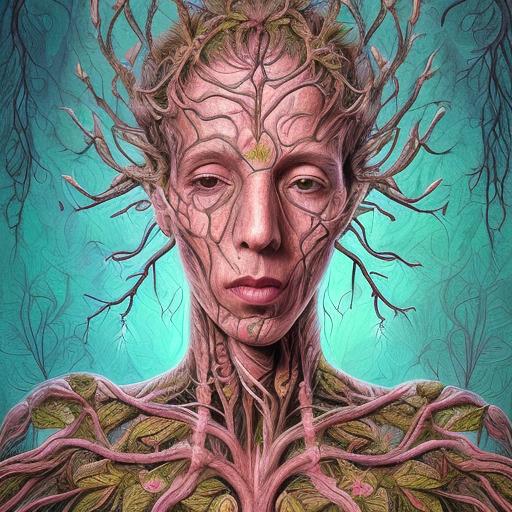Becoming a Tree (2023)
|
Arbohumuses are found in areas with a high concentration of trees and plants, where they are able to blend in with their surroundings and live symbiotically with other plants and animals. They are primarily herbivorous, feeding on a variety of plants and fruits, and may occasionally consume insects or small animals. They are able to reproduce through a combination of sexual and asexual reproduction, and typically give birth to offspring that exhibit a mix of human and tree-like traits. |
The Arbohumus is a hybrid species resulting from the combination of human and tree traits. Members of this species exhibit a humanoid form with bark-like skin, leaves instead of hair, and root-like appendages that allow them to anchor themselves to the ground and absorb nutrients. They are photosynthetic, deriving energy from sunlight like plants, and possess both human and plant organs, including a heart, lungs, and a circulatory system, as well as chloroplasts and a phloem system. |
|
An Arbohumus song would begin with a series of chemical signals that convey the mood and intention of the singer, followed by a complex sequence of vibrations produced by the movement of their branches and leaves. These vibrations could be synchronized with the chemical signals to create a rich and nuanced musical language, conveying information about the singer's emotions, intentions, and surroundings. The song might also incorporate elements of the natural world, such as the chirping of birds or the rustling of leaves in the wind, adding depth and complexity to the musical landscape. It is possible that the song would be sung in a group, with each Arbohumus contributing their own unique blend of chemical signals and vibrations to create a rich and harmonious melody. |
Arbohumuses communicate with each other through a combination of chemical signals and vibrations. Trees, for example, release chemical signals called pheromones to communicate with each other and with insects, while also using their root systems to exchange nutrients and other substances. Arbohumuses build on these forms of chemical communication to develop a more complex language. In addition to chemical signals, Arbohumuses also use vibrations to communicate. Trees, for example, can produce sound vibrations by moving their leaves or branches in the wind, which can convey information about the strength and direction of the wind. Arbohumuses develop more complex ways of producing and interpreting vibrations, potentially allowing them to convey information about their surroundings or coordinate their activities with others. |
|
Given that the Arbohumus is a hybrid of a human and a tree, it's possible that their response to touch might be somewhat different from that of a typical human or tree. For example, the tree-like aspects of the Arbohumus might make them more sensitive to physical contact, particularly in the areas where their branches and leaves are located. They might also have a heightened ability to sense vibrations and changes in their immediate environment, allowing them to detect human touch even if it's very light. Arbohumuses play the game "Branching"
The game is played by two or more arbohumuses, each standing on their own root system. The objective of the game is to extend one's branches as far as possible without touching the branches of any other player. To start the game, the players raise their branches up in the air and then lower them simultaneously, touching the ground. The players then take turns extending their branches outward, trying to cover as much ground as possible without touching the branches of any other player. If a player's branch touches another player's branch, that player is out of the game. The last player standing is the winner. The game requires a combination of strategy, dexterity, and quick reflexes. It is a fun way for arbohumuses to test their abilities and compete with each other in a friendly manner. |
The Chloroheart is a unique organ found only in Arbohumus creatures. It is a specialized form of the heart that pumps a mixture of chlorophyll and hemoglobin throughout the body. The chlorophyll allows the Arbohumus to photosynthesize and produce its own energy, while the hemoglobin provides the necessary oxygen for respiration.
The Chloroheart is located in the center of the chest, just like the human heart. It has a complex structure consisting of multiple chambers and valves that work together to circulate the chlorophyll and hemoglobin mixture throughout the body. Arbohumuses are able to regulate the function of their Chlorohearts depending on their environmental conditions. When there is ample sunlight, the Chloroheart works more efficiently to produce energy through photosynthesis. When sunlight is limited, the Chloroheart will increase its pumping of hemoglobin to ensure sufficient oxygen is being delivered to the body's tissues. The Chloroheart is a remarkable adaptation that allows Arbohumuses to thrive in their unique environment and make the most of their hybrid nature as both trees and humans. |









